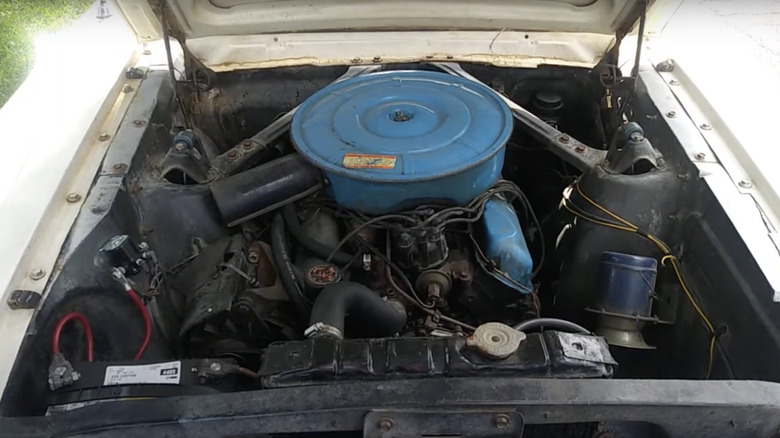4 Of The Slowest Mustangs With The Least Horsepower
Since its introduction at the 1964 World's Fair in New York, the Ford Mustang has become one of the longest-running and most beloved models in automotive history. The first six generations carried the Mustang through 2023, and the Mustang Mach-E brought the badge into the realm of electric vehicles for the 2021 model year. The most potent engines used in the Mustang over its long run have been primarily V8s, but the current version can be outfitted with a 2.3-liter, four-cylinder EcoBoost engine that makes an impressive 315 horsepower.
There are a few Mustangs that haven't had that ability to light up the tires, though, and some of them could barely outpace today's modern economy cars.
Let's take a look at the Mustangs that occupy the lower end of the horsepower and performance spectrum, and see how they compare with some other cars on the road.
[Featured image by SG2012 via Wikimedia Commons | Cropped and scaled | CC-BY-SA 2.0]
The original mustang had a wimpy inline-six engine
When the Mustang was first introduced to the public, the base engine was a 170 cubic inch inline-six that produced just 101 horsepower and 156 pound-feet of torque. The engine was shared with the Falcon, and Car and Driver called it "about as exciting as a dish of baby food."
The weak standard engine didn't stop eager buyers from driving 22,000 Mustangs home on the first day the car was available, and sales topped a quarter of a million units by the end of 1964. The first Mustang built went to airline pilot Captain Stanley Tucker, who convinced a Canadian salesman named Harry Phillips to sell him a white convertible on April 14, three days before the Mustang was to officially go on sale. "He saw it on the road and I was the lucky one that was closest to him at the time," Phillips told CNN. "He looked at it and said, 'It's mine.'" Ford convinced Tucker to allow the dealership to display the car for two weeks, but "he came in every day to check it out and make sure no one did anything to it," according to Phillips. Two years later, Tucker finally let Ford have the pre-production Mustang back, accepting the one millionth Mustang produced in return.
Some early V8-powered Mustangs weren't exactly speed demons
The 170-inch inline-six wasn't the only underpowered engine option for early Mustang buyers like Stanley Tucker. In its first two years, the Mustang was also offered with a 260 cubic inch V8 that was only capable of 164 horsepower and 193 pound-feet of torque. The next-best choice was a 210-horsepower, 289 cubic inch small block that later appeared in different configurations in the Fairlane, Comet, Cobra, and even Ford's NASCAR racers. Car and Driver tested the 210-horsepower version of the 289 at 8.2 seconds from 0-60 and 16.4 ticks to cover a quarter mile.
The high-output K-code 289 was capable of 271 horsepower, and C&D clocked the '65 Mustang with that engine at a more impressive 5.2 seconds from 0-60 and 14 flat for the quarter mile. While those aren't astonishing benchmarks by modern standards, the K-code Mustang's 0-60 time was seven tenths of a second faster than that of the 1965 Corvette.
1974 was the only year the Mustang didn't get a V8
The Mustang got steadily more capable as the '60s progressed, but new emissions and fuel economy standards emerged in the early '70s. The oil embargo of 1973 shifted American buyers' attention to more fuel-efficient cars as well, and Ford's answer was to redesign the Mustang for the 1974 model year. The Mustang II was meant to challenge imports like the Toyota Corolla and Volkswagen Beetle, and was built on the same platform as the unfortunate Pinto. The base 140 cubic inch four-cylinder was merely a slightly larger version of the Pinto's I4, and produced just 118 horsepower.
Buyers could also opt for a 171 cubic inch V6, but that motor barely topped 100 horsepower on the dynamometer. How Stuff Works cites a woeful 0-60 time of 13-14 seconds for the V6-powered Mustang II, which it blames on the curb weight that approached 3,000 pounds. In comparison, the 2025 Mustang Mach-E can get from a dead stop to 120 miles per hour in 13.9 seconds, according to Car and Driver. The 1974 Mustang also holds the dishonor of being the only vintage of the model never to be offered with a V8.
The weak I4 was carried over into the Fox body era
The Mustang got another redesign for the 1979 model year, but for some reason Ford brought along the pitiful 2.3-liter four-cylinder as the base engine for the new Fox body version. An optional turbocharger boosted output to about 130 horsepower, and two six-cylinders and a V8 rounded out the option sheet. None of these engines were stellar performers, though. Car and Driver tested the turbocharged four at 9.1 seconds from 0-60 and 17.4 clicks over the quarter mile. Both of those times are two seconds slower than those of the 2023 Toyota Prius, which exactly zero industry pundits consider a performance car.
The bigger engines didn't fare much better. The 5.0-liter V8 put out around 150 horsepower, which is a little less than the base engine in the 2024 Honda Civic. The V8-powered 1979 Mustang took 8.3 seconds to get from 0-60 and 17.4 seconds to cover a quarter mile. In 1980 and 1981, Ford temporarily abandoned the 5.0-liter V8 in favor of a 4.2-liter version that was as much of a disappointment. Its 132 horsepower and 142 pound-feet of torque took 10.8 seconds to get the Mustang to 60 miles per hour and 18.2 seconds to cover a quarter mile. The 2023 Toyota Prius would leave that Mustang in the dust with its 7.1-second 0-60 time and 14.1-second quarter mile pace.




